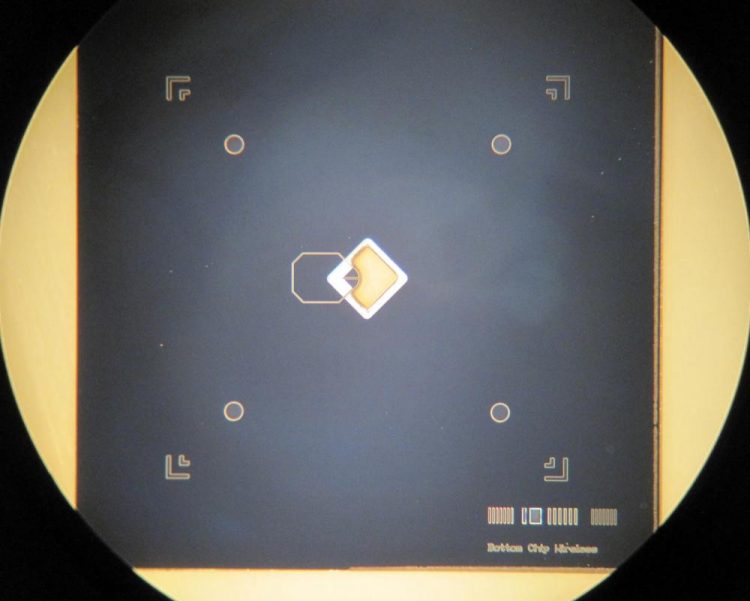Microscopic trampoline may help create networks of quantum computers

This chip, designed by researchers at JILA and measuring less than a half-inch across, converts microwave energy into laser light. Credit: Peter Burns and Dan Schmidt
Scientists at JILA, a joint institute of CU Boulder and NIST, have developed a device that uses a small plate to absorb microwave energy and bounce it into laser light–a crucial step for sending quantum signals over long distances.
Graduate student Peter Burns said that his team's research could one day help engineers to link together huge networks of quantum computers.
“We're anticipating a growth in quantum computing and are trying to create a link that will be usable for these networks,” said Burns, one of two lead authors of the new study.
Over the last decade, several tech firms have made inroads into designing prototype quantum chips, which have the potential to be much more powerful than traditional computers. But getting the information out of such chips is a difficult feat.
One big challenge lies in translation. Top-of-the-line quantum chips like Google's Bristlecone or Intel's Tangle Lake send out data in the form of photons, or tiny packets of light, that wobble at microwave frequencies. Much of modern communications, however, relies on fiberoptic cables that can only send visible light.
In research published today in Nature Physics, the team reports that zapping a small plate made of silicon-nitride with a beam of microwave photons causes it to vibrate and eject photons from its other end. But those photons now quiver at optical frequencies.
The researchers were able to achieve that hop, skip and a jump at an efficiency of 47 percent, meaning that for every two microwave photons that hit the plate, close to one optical photon came out. That's a much better performance than other methods for converting microwaves into light, such as by using crystals or magnets, Burns said.
He added that what's really impressive about the device is its quietness. Even in the ultra-cold lab facilities where quantum chips are stored, trace amounts of heat can cause the team's trampoline to shake. That, in turn, sends out excess photons that contaminate the signal. To get rid of the clutter, the researchers invented a new way to measure that noise and subtract it from their light beams.
“What we do is measure that noise on the microwave side of the device, and that allows us to distinguish on the optical side etween the signal and the noise,” Burns said.
The team will need to bring down the noise even more for the trampoline to become a practical tool. But the potential benefits are huge, said Konrad Lehnert of JILA and a co-author of the new research.
“It's clear that we are moving toward a future where we will have little prototype quantum computers,” he said. “It will be a huge benefit if we can network them together.”
###
Andrew Higginbotham, now at Microsoft Research, was the co-lead author of this research. Other co-authors included Maxwell Urmey, Robert Peterson, Nir Kampel, Ben Brubaker, Graeme Smith and Cindy Regal, all at JILA. Additionally, Smith is an assistant professor and Regal is an associate professor in CU Boulder's Department of Physics.
Media Contact
All latest news from the category: Information Technology
Here you can find a summary of innovations in the fields of information and data processing and up-to-date developments on IT equipment and hardware.
This area covers topics such as IT services, IT architectures, IT management and telecommunications.
Newest articles

First-of-its-kind study uses remote sensing to monitor plastic debris in rivers and lakes
Remote sensing creates a cost-effective solution to monitoring plastic pollution. A first-of-its-kind study from researchers at the University of Minnesota Twin Cities shows how remote sensing can help monitor and…

Laser-based artificial neuron mimics nerve cell functions at lightning speed
With a processing speed a billion times faster than nature, chip-based laser neuron could help advance AI tasks such as pattern recognition and sequence prediction. Researchers have developed a laser-based…

Optimising the processing of plastic waste
Just one look in the yellow bin reveals a colourful jumble of different types of plastic. However, the purer and more uniform plastic waste is, the easier it is to…



